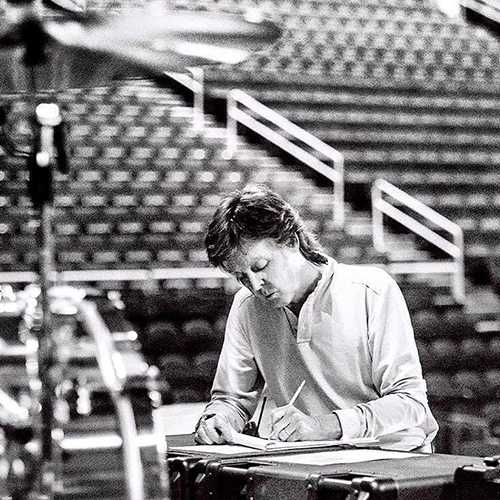Wednesday, August 21, 1968
Recording and mixing "Sexy Sadie"
For The Beatles
Last updated on October 27, 2024
Wednesday, August 21, 1968
For The Beatles
Last updated on October 27, 2024
"The Beatles" (aka the White Album) sessions
May 30 - Oct 18, 1968 • Songs recorded during this session appear on The Beatles (Mono)
Recording studio: EMI Studios, Studio Two, Abbey Road
Interview Aug 17, 1968 • Paul McCartney interview for New Musical Express (NME)
Session Aug 20, 1968 • Recording "Yer Blues", recording and mixing "Mother Nature's Son", "Wild Honey Pie"
Session Aug 21, 1968 • Recording and mixing "Sexy Sadie"
Session Aug 22, 1968 • Recording "Back In The U.S.S.R."
Session Aug 23, 1968 • Recording and mixing "Back In The U.S.S.R."
AlbumSome of the songs worked on during this session were first released on the "The Beatles (Mono)" LP
On this day, The Beatles completed “Sexy Sadie” in a session that lasted from 7:30 pm to 7:15 am. The basic track had been recorded on August 13, following some prior unsuccessful attempts.
George Harrison had just returned from a holiday in Greece and likely joined the session halfway through.
The session started with a reduction mix of take 107, labeled as 112, which included heavy flanging and repeated echo effects on the piano (the four reduction mixes from August 13 were not satisfactory).
On Take 112, John Lennon, Paul McCartney, and George Harrison contributed backing vocals, George added lead guitar flourishes, and Paul laid down a second piano track.
Subsequently, three tape reductions, Takes 113 to 115, were made, with Take 115 being deemed the best. On Take 115, John double-tracked his lead vocals in certain places, Paul added some organ, and Ringo Starr supplemented with tambourine.
This was followed by two more tape reductions, Takes 116 and 117. Paul then recorded a bass part onto Take 117, completing the recording process.
The session then moved on to creating the mono mix. Five attempts, labeled RM1 to RM5, were made.
RM5 was deemed the best but was 39 seconds longer than what was eventually released on the White Album, due to the inclusion of an instrumental bridge during the song’s conclusion, which was omitted from the released mono mix. The additional bridge was removed from the master mono version of the song before the mono master of the White Album was compiled, likely during the 24-hour session on October 16/17 when the album was finalized for release.
A tape copy of this extended RM5, made on August 23, was taken by Mal Evans and handed to Ringo Starr, who in turn gave it to his friend Peter Sellers. This version with the extra instrumental bridge surfaced on bootleg albums.
The stereo mix was made on October 14.
Tape copying • Tape reduction take 107 into take 112
Recording • SI onto take 112
Tape copying • Tape reduction take 112 into take 113
Tape copying • Tape reduction take 112 into take 114
Tape copying • Tape reduction take 112 into take 115
Recording • SI onto take 115
Tape copying • Tape reduction take 115 into take 116
Tape copying • Tape reduction take 115 into take 117
Recording • SI onto take 117
Mixing • Mono mixing - Remix 1 from take 117
Mixing • Mono mixing - Remix 2 from take 117
Mixing • Mono mixing - Remix 3 from take 117
Mixing • Mono mixing - Remix 4 from take 117
Mixing • Mono mixing - Remix 5 from take 117
The Complete Beatles Recording Sessions • Mark Lewisohn
The definitive guide for every Beatles recording sessions from 1962 to 1970.
We owe a lot to Mark Lewisohn for the creation of those session pages, but you really have to buy this book to get all the details - the number of takes for each song, who contributed what, a description of the context and how each session went, various photographies... And an introductory interview with Paul McCartney!
The Beatles Recording Reference Manual: Volume 4: The Beatles through Yellow Submarine (1968 - early 1969)
The fourth book of this critically acclaimed series, "The Beatles Recording Reference Manual: Volume 4: The Beatles through Yellow Submarine (1968 - early 1969)" captures The Beatles as they take the lessons of Sgt. Pepper forward with an ambitious double-album that is equally innovative and progressive. From the first take to the final remix, discover the making of the greatest recordings of all time. Through extensive, fully-documented research, these books fill an important gap left by all other Beatles books published to date and provide a unique view into the recordings of the world's most successful pop music act.
If we modestly consider the Paul McCartney Project to be the premier online resource for all things Paul McCartney, it is undeniable that The Beatles Bible stands as the definitive online site dedicated to the Beatles. While there is some overlap in content between the two sites, they differ significantly in their approach.

Notice any inaccuracies on this page? Have additional insights or ideas for new content? Or just want to share your thoughts? We value your feedback! Please use the form below to get in touch with us.